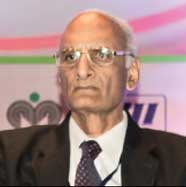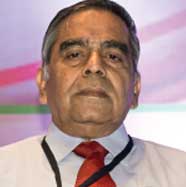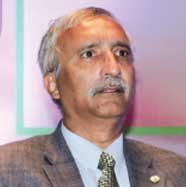The event saw some real issues tackled in its extensive technical sessions to realize the industry’s aspirations of being lean and green.
CII – Sohrabji Godrej Green Business Centre in partnership with Indian Paper Manu-facturers Association (IPMA) organised the 9th edition of PaperTech 2015 on 15 & 16 July 2015 at HICC, Hyderabad. Through PaperTech, CII – Sohrabji Godrej GBC with the support of all the stakeholders of Indian paper sector aims the performance improvement in energy and environment in the Indian pulp and paper industry. The platform PaperTech has come a long way since its beginning and now garners tremendous support from the industry in addressing some of the crucial technological and technical guidance issues.
Continuing the tradition of making a difference on certain areas of concern, PaperTech 2015 revolved round objectives such as disseminating the information on latest technologies for energy efficiency, water and environment performance improvement; facilitating the sharing of best practices amongst Indian pulp and paper plants; involving more paper plants including small and medium plants in the activities related to the current edition’s theme of “Make Indian pulp & paper industry world class” for their benefit; sharing the best practices amongst the Indian pulp and paper Industry.
PaperTech 2015 saw six intensively discussed technical sessions, each focusing on a distinct subject where efforts were made to reach on practically applicable solutions. The six technical sessions respectively dealt issues such as Facilitating Latest Technologies in Pulp and Paper Making; Technical Panel discussion – PAT scheme for Pulp & Paper; Solar Energy Application for Pulp and Paper Sector; Water Conservation and Management; Waste Management Applications for Pulp & Paper Industry; Cogeneration and Steam Systems & Energy Management in Pulp and Paper Sector.
Besides, the inaugural session came forth with innumerable insights presented by the doyens of the industry. Present on the dais in the inaugural session were Mr. K. S. Kasi Viswanathan, Chairman PaperTech 2015 & MD, Seshasayee Paper and Boards Ltd.; Mr. N. Gopalaratnam, Chairman, Seshasayee Paper and Boards Ltd.; Mr. Sanjay Singh, Divisional Chief Executive, ITC Limited – Paperboards & Specialty Papers Division; and Mr. S. Raghupathy, Executive Director, CII – Sohrabji Godrej Green Business Centre.
Continuous Improvement

Initiating with the theme address, Mr. K. S. Kasi Viswanathan underscored the significance of platforms like PaperTech and gave a brief outline of the day program unfolding over two days. He said, “We started this journey in 2007 and today we are organizing the 9th edition of PaperTech. The objective as always has been to facilitate the continual improvement in the performance of the Indian pulp and paper industry, and, as a system, move towards world class standards as is emphasized by the theme this year. The focus areas in this edition of PaperTech are energy efficiency, water conservation and management, waste management, etc.
“Needless to say, the market is very tough today leading to a lot of competition and falling prices of paper. Sky rocketing prices of key input raw material is another major concern. You won’t believe that for some of our basic input material, such as wood, the prices have gone up by about 100 percent in the last 2-3 years. While prices are a concern, availability of raw material is yet another problem and there is increasing competition for securing the raw material which is limited.
“Moreover, as we are trying to replace many things with paper, other industries are also coming up with products as a replacement to the paper. The paper today, especially the W&P paper, is experiencing a tremendous amount of pressure from newer alternatives like e-media.”
On water and energy conservation and management side, Mr. Viswanathan said, “There is immense pressure to reduce the water consumption in the mills. At one time, the industry was consuming about 300 cubic meters of water, for producing one tonne of paper in an integrated mill, which has subsequently gone down to 50 cubic meters due to constant effort put in by the paper mills. By striving to achieve lower water consumption, two things happen – one, your operating efficiency improves and two, it’s legal and statutory requirement by which you necessarily need to bring down the water usage by a certain prescribed degree.
“There are regulatory provisions by the Govt. where you are not allowed to consume beyond a limit, nor are you allowed to discharge effluents beyond a specified limit. These provisions should be seen as something positive adding to competiveness in the industry. We should not get unduly worried over this competitiveness – unless we are competitive, how are we going to survive?
“There are myriads of problems on various front for which there is no single solution. I am not talking about the industry as a whole; I am referring to individual mills – as problems differ from mill to mill. Ideas can be taken away from such conferences, but it is the individual company who has to find out ways for specific problems it’s facing.
“We have come a long way through PaperTech learning and implementing many good ideas in our mills. In each PaperTech we try to do something which is unique and different from previous editions. A variety of methods have been adopted for the benefit of overall paper industry and we have set an excellent example of learning through sharing.
“In order to become clean, green and efficient, we are working with different agencies like UNIDO, SEA, and Shakti Foundation to help the pulp and paper industry grow. With UNIDO, we are working on “Greenhouse Accounting” which helps you understand how green you are and tells you ways to keep track GHGs emissions at every stage of operations in a mill.
“The other agency CII is working with is the Swedish Energy Agency (SEA) which works for the use of renewable energy, improved technologies, a smarter end-use of energy, and mitigation of climate change. Our two delegations have already been to Sweden to attend various extremely well organized programs where we visited many mills to understand issues, saw live presentations, and held discussions with individuals to find ways towards cleaner energy technology. SEA facilitates innovation acceleration in clean technology area in partnership with the Indian and Swedish companies.
“Another agency is Shakti Sustainable Energy Foundation with which we are working to explore the ways to harness renewable energy which has tremendous scope in times to come. The foundation facilitates India’s transition to a sustainable energy future by promoting policies that encourage energy efficiency as well as the increased generation of renewable energy. Last year, we published a compendium of various technologies available under Shakti Foundation; technically feasible and financially viable technologies have been identified and further steps are being taken to facilitate the implementation of these technologies.
Changing Wrong Perception

The paper industry worldwide has been the subject of an acute misconception that it’s anti-forest and thrives on felling trees and clearing forests. Of late, the industry has expressed its stern objection to such perception and media spreading such myths. Mr. Sanjay Singh has one of the noted votaries of actions intended for the removal of such wrong image from populace’s mind. He said, “We need to improve the image of the paper industry; it’s too much of negativity. You open a mail only to find a message in the bottom saying “Don’t print this mail, save trees”. This is totally wrong and portrays not-so-good image of our industry. This will have to change. PaperTech may prove to be a very powerful tool in changing that image.
“We need to spread the awareness that paper is not produced from trees of the forest. The wood requirement for industry’s pulp is catered through social farm forestry where we not only grow our own tress, but plant far more than we actually cut. So, from that standpoint, using more paper will lead to planting more trees and hence a greener environment. ITC has covered more than 2 lakh hectares of wood plantations in Andhra Pradesh and in a way have increased the green cover of the nation.
“We also require making people aware that paper is the most eco-friendly of products and reusable; the users do not need to dispose paper as garbage, but they can use the concept of source-segregation so that paper can be recycled. ITC has a mill in Coimbatore which is 100 percent waste paper based. When we started the mill, we used to rely fully on imports for the waste paper as it was not adequately available in the country. Over the years, we started the program called “WoW” to collect the waste paper from homes, offices, industries, etc. Today, the percentage of domestically collected waste paper in the total input of that mill has improved drastically.
“CII has a GreenCo Rating award and this is first of its kind green rating in the world initiated by the CII to push the green agenda in the country. I am happy to say that ITC Ltd- Paperboards & Specialty Papers Division, Kovai Unit’ has been certified as a “GreenCo Platinum” and ‘Bhadrachalam Unit’ as “GreenCo Gold” company. ITC-PSPD has also achieved the distinction of becoming the first pulp and paper company to be certified under the GreenCo Rating. It just shows that there is no reason why the paper industry can’t be rated well on the environment performance index.
“The purpose of PaperTech is to disseminate good practices among industry players in order to move towards raw material, energy, and water conservation. A lot of good things are happening on front of conservation and management side. Water consumption in integrated mills are now well below 50 cubic meters mark for producing one tonne of paper and 40-50 percent of our energy consumption is coming from lignin and bark that we use in our mills.
“However, what concerns me the most is the color of effluents that we discharge. Because of color, many thinks that our effluents are polluting the water bodies, however there may be other factors responsible for this pollution. So, as a team we need to find out some technical solution for getting colorless effluent. As a process in the direction, ITC decided to invest in a zero-discharge CTMP mill. For a normal pulping, zero-discharge mill may not be possible, but for a CTMP mill technologies are available.
Paper is Secure

The majority in the paper industry is concerned about the current sluggish growth curve and anticipating whether paper as a commodity will see resurgence in near term future. Mr. N. Gopalaratnam, however, is of different opinion and says paper’s future is secure as it’s one of the most eco-friendly and sustainable of products. He vividly explained why the East and rapidly emerging markets (RGMs) are poised to see a tremendous growth in paper segment.
“From 1990s onwards, there has been a visible shift of economic power from the West to the East, and of course, China. Paper is a product whose growth is directly proportional to the GDP growth – GDP is generally an indicator for the paper growth in years to come. Today, especially in the last couple of years, we are somewhat lagging in our GDP growth and, to a large extent, that has contributed to certain amount of deceleration in the growth of the paper industry. But, I don’t think that’s the end of the world as far as the paper industry is concerned. Paper seems to be quite secure.
“Tremendous amount of urbanization and growth of the middle class population are taking place which normally contribute to a higher growth of the paper industry. We have also a reliable forecast for a great rise in the middle class population – out of 7 billion world population; 1.8 billion is the middle class which will further grow by another 3 billion. Along with this rising middle class, purchasing power will witness a perceptible growth which will benefit all industries including paper. India and China are two identified nations for paper growth and paper’s growth in India, in terms of percentage, will be higher than that of China’s as our base is smaller.
“In this whole thing, we have to plan and manage our plantations well to be ahead of time. The concept of renewable energy and carbon footprints must be embraced in order to be consistent with our objectives of becoming more green and sustainable industry. If we take care of some of these things, I am sure the balance in the market forces will reappear very soon leading to a greater demand of paper.
“There are a lot of rapidly emerging markets (RGMs) like South Africa, Mexico, Columbia, Vietnam, Thailand, etc. which will also contribute greatly to the growth of paper consumption worldwide. However, a paradox exits – key technologies and equipments are with Western Europe where the paper market has matured; then there is South Africa with all the raw material, but paper consumption is very minimal; you have Far East like India and China with tremendous growth potential and huge markets, but there is fiber scarcity. Therefore, there is going to be a tremendous amount of cross-flow of technology, fiber, and management expertise – all this will lead to a balance eventually.
“This is not the best of times for the paper industry. We are witnessing a huge squeeze because of rising cost, sluggish demand and bickering paper prices. It’s largely due to excess capacity unable to get absorbed because of weak growth of economy in the last couple of years.
“But, the real issue is imports. Taking advantage of zero import duty from ASEAN countries and we find that lots of paper are being imported, especially the cut-sizes and copier grades. In terms of volume, it has grown by more than 20 percent annually in the last five years. And this is something which really seeks our attention and we must see what can be done to eliminate such kind of indiscriminate dumping.
“The perception about paper is also a serious issue as Mr. Sanjay Singh pointed out. We know that we are a sustainable industry from raw material, product and process points of view. Paper as a product is recyclable and recoverable; it is recycled to the extent of 60-70 percent throughout the world. I don’t know any other product which can be recycled fairly extensively as paper. We have raw materials such as wood, agro-residue, and waste paper – all are definitely renewable. UK Sustainablity Commission has rated the paper industry as one of the most sustainable industry.
“Therefore, from all view-points – we are in growth market like India; we have product which is sustainable; the market is moving towards the Far East, etc. – the future of the paper industry will definitely be brighter than what we see today.”
World-Class Initiatives
CII-Sohrabji Godrej Green Business Centre (CII-Godrej GBC) was established in the year 2004, as CII’s Developmental Institute on Green Practices & Businesses, aimed at offering world class advisory services on conservation of natural resources. CII-Godrej GBC has been organizing various path-breaking initiatives in consultation with the concerned stakeholders for resource conservation through clean technology. PaperTech is such an initiative.

Elaborating more on the actions undertaken by CII-Godrej GBC, Mr. S. Raghupathy, in his concluding remarks, said, “As Mr. Sanjay Singh has articulated beautifully about the GreenCo Rating System, this is first of its kind in the world – I am using the word ‘in the world’ as many other countries tried doing it only to fail miserably. This is an activity where we try to several sectors of industry. But, “how an apple can be compared to an orange” sort of questions crops up during the activity. For example, cement industry is on the same platform as industries like paper, textile, or steel. However, the comparison is done within the sector with similar strategies and approaches. This is working wonders with 140 companies taking the lead and 48 being certified. We strongly believe that this can revolutionize the green market in India. The reason why this can revolutionize is that it takes the holistic picture right from the raw material state to the final shaping of the product. It captures everything and gives you a complete framework as to what a company should do.
“The other interesting thing that we are doing is the Green Power Market Development Program. The Confederation of Indian Industry (CII) and the World Resources Institute (WRI) launched India’s first Green Power Market Development Group (GPMDG). The objective of the GPMDG is to scale-up Indian green energy markets and enable corporate buyers to access reliable and clean energy, diversify their energy portfolios with green power and reduce their impact on climate change while creating new opportunities for renewable energy supplier and technology providers.
“The paper industry and the CII can work together in developing a “low carbon technology roadmap”. This was successfully done for the cement industry, one of the most energy intensive industries, whose specific GHGs emission is in the region of about 0.7 tonne of CO2 for one tonne of cement. Now they have clear-cut plans for reducing their emission by about 50-60 percent over a period of next 30-50 years. Well-defined technology roadmap has been developed and now many cement companies are pursuing it. The point is that if you have the roadmap, credibility of your industry drastically goes up.
“Coming to ‘Make in India’, I wish to ask why pulp can’t be produced 100 percent within our country. For me, this is very difficult to understand. I am not sure about figures, but indications are that about Rs. 4000-5000 crores are spent every year in importing the pulp. There is a great opportunity for CII and IPMA to explore possibility of producing enough pulp here in India so that we can save the huge sum going out. You are the experts of the field and CII would be delighted to work with you to make this happen.
“The proof of this seminar lies in actions which come out of it. My earnest request to each of you is to choose tow-three areas where you can make a difference and we in CII would be delighted to be a part. All of us have one goal, one commonality, one purpose – we are working to make our country green.”


